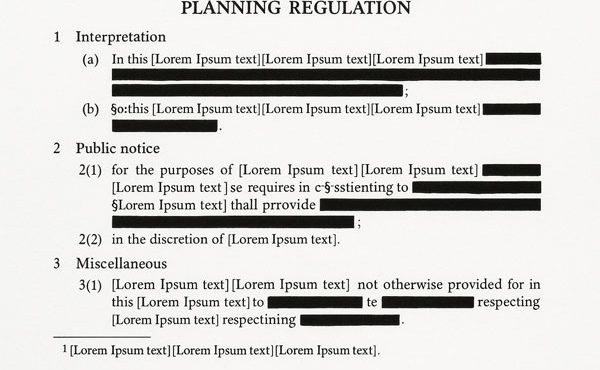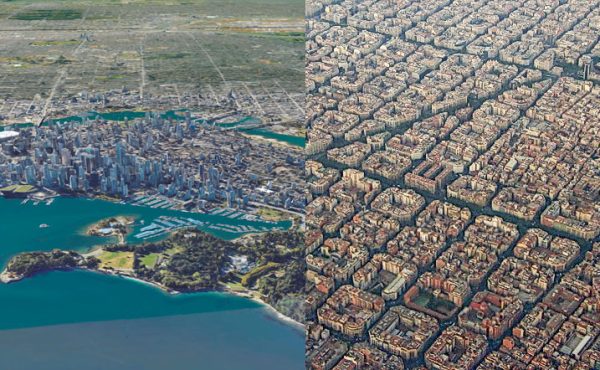
Dense /dens/ (adjective)
1 marked by compactness or crowding together of parts
2 slow to understand: thickheaded
The BC Government recently released its legislation plans to build more homes near transit hubs and talk is buzzing. As someone who actively attempts to communicate foundational knowledge about these issues—breaking myths and misinformation along the way—the release offers us a first-hand example of how deeply engrained misunderstandings are about housing, built-form, density, Transit-Oriented Development, and affordability are within government circles. Although there are many false assumptions and vague terms in the release worth thinking closely about, I want to focus on the themes mentioned above—ones that I’ve written at length about in different S101S pieces published over the past year.
Before digging in, however, it’s important to say that this is not a critique of the intentions behind the government’s legislation but of their methods, and the assumptions that support them. I think it’s fair to say that how and where to provide housing is—and always has been—a major problem facing all cities. Careful thought, actions and choices need to be made and cities need to provide housing for incoming and growing populations: housing that is safe, liveable, and attainable. Period. The problem with the legislation proposal is with the how and not the what.
Also worth noting is that these are very complex and nuanced issues, so although I’ll attempt to summarize some of the main issues here, it won’t be comprehensive and I will rely on my S101S pieces to fill in the gaps. These will be linked to throughout, and at the end of the piece for folks interested to get a more in-depth understanding.
Let’s start the festivities…beginning with the easy targets. That is, clear examples of common confusion and erred thinking. Here are some facts:
“High-density” homes and affordability are not necessarily connected. Many governments use the terms in ways that read like one (density) causes the other (affordability) or that (density) is necessary precondition for the other (affordability). The rhetoric is almost mathematical: high-density housing = increased affordability. This is clearly evident in the release as their plan works “…to leverage public lands to build more affordable housing in connected, livable communities”. Sadly, There is plenty of evidence to the contrary. Some of the most expensive real-estate in the world is in “high-density” in transit-friendly neighbourhoods at that. This is not to say that high-density housing cannot be affordable. It is surely possible. But the legislation does not tackle affordability in any direct way—for example, providing affordability targets or measures that must be met. Instead, it assumes that an increased quantity of houses, in the form of “high-density” housing, will magically make it affordable. Wrong. Things are not that simple. Targets need to set, measured and enforced. Context matters.
The simplistic “supply and demand” argument was overturned years ago. It is much more complex and nuance, as highlighted by the insights of renowned planner Alain Bertaud in Order without Design. Locally, Understanding Affordability: A Partial Picture attempted to apply his methods to the Vancouver context, and Bertaud responded in kind to further refine his work to local conditions. Ultimately, if the world was as simple as the BC Government states in their release, places like downtown Vancouver and Manhattan would be the most affordable places in the world.
Transit-Oriented Development is not necessarily good for people and communities. Placing folks near transit can certainly benefit neighbourhoods through access to services, but it also does not necessarily “…create vibrant and livable neighbourhoods…” as the government release nonchalantly argues. Transit-Oriented Developments have also been directly connected to the displacement of long-time residents, increased unaffordability, loss of local character and cultural diversity, as well increased pressure on existing infrastructure (such as schools, parks, and health care) which can be difficult for communities to accommodate. All is not sunshine and lollipops. Again, context matters. Assuming that their legislation will benefit all communities is optimistic (to the point of fiction), at best…ignorant and extremely irresponsible, at worst. The government is silent about how it intends to minimize the negative impacts of their development plans.
Transit-oriented development does not necessarily mean “high-density” housing or residential towers. As I have written elsewhere, not all TODs result in “high densities”, and not all “high-density” developments are TODs. Context matters. In fact, there is no official standard or definition for “high”, “medium”, and “low” densities in urban planning and design. This vagueness makes it particularly easy to misuse and for those with less-than-noble motives to pull up to legitimize dubious claims. Similarly, the principles of Transit-Oriented Development do not specify a building type (i.e. towers) or density numbers. Successful TOD can, and has, been done without very high-density building types, including residential towers. Here we go again…a broken record: context matters. Unfortunately, many government officials and others in power, particularly those invested in residential towers, speak authoritatively as though high-rise developments are a pre-condition for TOD. This is the case for the BC government and is outright false.
Although there are many more “fake news” examples touted by the BC Government in its proposal beyond the hat-trick above, I want to end with taking a deeper dive into two particularly disgraceful examples of (perhaps wilful) ignorance: focusing on their Policy Framework and its explicit mandate of the “Minimum Allowable Height” of “Up to 20-story” towers and buildings of other heights for locations adjacent to their “Transit-Oriented Development Areas” (TOA).
Residential towers are not necessarily “high-density” building types. This seems counter-intuitive because towers look “high-density”, but many variables not related to building form go into calculating density—defined as the number of people living in a specific area. Variables that affect density include base land area and household size. Now, building type can affect density numbers, for sure, but again context matters. As I’ve written elsewhere, it’s assumed that detached houses are lower density than attached housing or that high residential density is synonymous with high-rise buildings. However, a tower with large units located in a park-like setting can have a lower density than a set of detached houses on small lots.
A wonderfully acute and critical cynic may respond: “…sure…but let’s wipe these broader variables from the table and focus on the building form itself. Within this context, towers are clearly the highest density form.” Red buzzer. Wrong.
How is that possible, you ask?
Well, in order to understand we have to delve into analyzing building types—more specifically, “formal” building types and architectural morphology—focusing solely on the physical and geometric characteristics of building forms.
I’ve covered this in more depth within The Tower Default – Part 2, but a quickly recap is necessary. In the late 60s, Leslie Martin and Lionel March explored the question of what building forms make the best use of land. Attempting to be as ‘objective’ comparing different building geometries based on the measurable criteria of daylight access and the ratio of floor area to site area as their metrics—aspects that they reasoned had public value. The results were published in 1972 in the book Urban Space and Structure.
Six simple configurations—gathered across urban history—were analysed in detail, with the tower (or ‘pavilion’) and courtyard building forms offering the extremes. To the surprise of many, courtyard buildings—like those found in older settlements, like Cerda plan of Barcelona—were found to be optimal. This was one of the first studies to break the now common myth that towers are the only building form able to generate significant urban density. More recent studies like Density and Built Form—by well-known architectural morphologist Philip Steadman—served to further prove Martin and March’s initial findings.
Let’s be clear about their findings: ‘pavilions’ (including towers) are not the densest building types when liveability factors including daylighting and floor-to-site area ratios are factored in. The math is explicitly clear. “Lower” building types are capable of producing and/or exceeding the densities of tower building forms. This makes sense intuitively once we remember our high school math classes that demonstrated that (lower) forms that travel along the perimeter of a shape can have areas (densities) equal to or greater than freestanding shapes within the same footprint. By extension, lower forms designed the perimeter of a lot can have areas and densities equal to or greater than freestanding forms within the same lot. Feel free to research it yourself. Scot Hein’s recently published Observations on Bill 47 describe several local examples of high-density non-tower projects.
But for those who continue to be non-believers, at the very least this points again to the fact that context matters. Remember, base land area affects density numbers and using a broad brush to paint all transit nodes as equal in terms of adjacent parcel sizes, lot areas, etc. Taking away choices based on local context is inherent destructive and naive. As I’ve mentioned a number of times above: context matters!
What this shows is that the assumptions casually put forth by the BC government through their proposed TOA regulations are (very) partial truths, at best, based on oversimplified criteria—criteria that are actually not being stated in the document. Specifying minimum heights, biasing tower developments is flawed thinking.
Finally, as an attempt to avoid what can arguably be one of the most heinous examples of government-sanctioned urbicide in local history, here is one last fact:
All building types require necessary spatial conditions. Mandating a building type(s) sanctions the (potentially radical) transformation of the urban fabric towards the creation of that type. I hope future S101S pieces will address this issue in more detail since it’s important to understand, but it’s also quite straightforward. Building types have particular spatial constraints required for their creation. Single-family freestanding homes, for example, need parcels that are large enough for the structure—created by putting together spaces large enough to inhabit—to be located within the lot without touching any of its lot edges. This creates a minimum range of lot sizes and areas within which one can build freestanding homes.
The same is true for all building types: each assumes the spatial conditions needed for their construction. When was the last time you’ve seen a high-rise residential tower on a 33ft-wide lot? A 50ft-wide lot? The closest examples you will find are only found in special places like Tokyo, Japan and those are typically 10-13 stories. Needless to say, they are extremely rare and require an abundance of careful thought to make livable. Now consider a tower with a 20-storey height minimum. How big do you think a lot has to be to support that?
The standard solution for building “high-density” developments located in smaller parcel neighbourhoods to amalgamate lots to the point where they can support the building type. Broadly speaking: larger building types need larger lots, and in areas where small lots are the norm, developers must create larger lots from the small. In doing so, they often erasing significant urban fabric and structures.
Now, implicit in the BC Government’s Framework is the assumption that all transit nodes and the urban fabric surrounding it are created equal. We know, however, that this is not true. The urban fabric around Nanaimo Station is drastically different than that around Landsdowne Station, for example. Looking at the headline image and Josh Messmer’s interactive map, is it fair to believe that the neighbourhoods and communities within all of those circles are the same? Clearly not.
So, it’s more accurate to say then that implicit in BC Government Policy Framework is that all transit nodes will be made equal, irrespective of context and no matter the on-the-ground implications. An appropriate slogan for the Government’s approach might be: when context gets in the way, just get rid of it.
This is ultimately an urban planning and design proposal masking itself as high-level provincial policy—a proposal that will radically huge areas of the existing urban fabric, without any meaningful input from the existing fabric and people it will directly affect.
Within this context (pun intended), it’s worth reflecting on the fact that municipal urban planning and design initiatives follow a process of informing and getting feedback from the communities that they intend to transform. This takes months, sometimes years, of back-and-forth.
As imperfect as the processes and results are, we can all agree that there is at least a cursory acknowledgement that engaging the public about their needs and desires—understanding the nuances that make each neighbour and community unique—is important. Municipal agencies employ people who are formally trained in handling the complexities of urban planning and design across different scales, for this very reason.
The BC Government’s proposal is simultaneously a slap in the face to municipalities that are currently handling the issues with care and wisdom, and the citizenry who are now being completely taken out of the equation of co-creating their communities—undermining their ability to advocate for the places they want to live in. Hardly a good look for a government that touts inclusivity and reconciliatory intentions.
That the Government and their advisors are fuelling misinformation about the fundamentals of TOD planning, affordability, density and building types shows a dense confusion about the important issues it’s tragically trying to address. The are ignorant in the truest sense: abstractions that are so generalized and exaggerated that they have the capacity to do incalculable harm.
I think it’s fair to say that there is a version of this process that recognizes that everybody do want affordable housing in thriving communities, and that working towards this goal can build and strengthen local communities instead of create division. That it can promote meaningful social exchange and resilience instead of conflict. Creating complete communities grounded in local context does this, creating pride of place, sharing and reciprocity. Instead of Transit-Oriented Development, we should aspire to People/Place-Oriented Development.
A mature approach to this conundrum would be for the BC Government to pause and withdraw Bills 44, 46, 47 for some serious reconsideration, getting further counsel from a wider representation of varying people, communities and institutions, including but not limited to those deeply immersed in the complexities of urban planning and design. I’m sure many—myself included—would be very open to organizing formal dialogues and briefings in support of the cause.
Ultimately, the issues the Government wishes to address are too complex and important to rush through. Why hurry when we have such a wonderful moment to build local capacity by giving permission and (funding) tools for local communities to co-create a future with more housing. The province would be bolder by thinking of this moment as a design challenge. In the words of Kao Kalia Yang “Patience is the road to wisdom.” And only wisdom will get us where we want to go.

***
Related pieces:
- S101S: Describing Building Types: Why They Matter
- S101S: Understanding Residential Density: Why is it so Confusing?
- S101S: Explaining Transit-Oriented Development: Benefits and Drawbacks
- The Tower Default – Part 1
- The Tower Default – Part 2
- S101S – Formal building types
- S101S – Describing Building types
- Philip Steadman: Density and Built Form
- Understanding Affordability: A Partial Picture
- Understanding Affordability: A Partial Picture – Bertaud’s Response
- Observations on Bill 47 by Scot Hein
- BC Bill 47 – Transit-Oriented Zoning Map
***
Erick Villagomez is the Editor-in-Chief at Spacing Vancouver and teaches within the UBC’s School of Community and Regional and KPU’s Wilson School of Design.





3 comments
Many many young people are cheering on these reforms. The nuances of “context” matter much less to someone on the precipice of having to move to Alberta to afford a place to live.
Also – using Manhattan as an argument that supply doesn’t influence housing prices is absurd to me. It’s supply AND demand, and we know that Manhattan is one of the most desirable places to live on Earth. Just having a high supply of housing is irrelevant if demand is similarly high. The question you really need to be asking is: what is the vacancy rate? That has been absolutely shown to be a major driver of affordability in urban areas.
An excellent article. I want to point out two broken links in the Related Articles list: “S101S: Describing Building Types: Why They Matter” and “S101S: Explaining Transit-Oriented Development: Benefits and Drawbacks”.
Cheers! Chris
I think the author of this article has a few very strange misconceptions about zoning. The first is the complaint about lots, tower forms, and height. The purpose of zoning is to set limits on what’s possible rather than to require a landowner or developer to build up to a certain height. When they say “sets explicit mandate of the minimum 20-storey towers,” some might believe that they are implying that developers will be required to build at that height, but it will not be the case. Similarly, if the tower is such an uneconomical form, as you say, then developers will build lower-rise buildings. The reality is that, regardless of how much you personally hate them, many people want to live in towers, in part because they offer nicer views, more private balconies, and more sunlight than many low-rise properties. I think denying people what they want makes about as much sense as me mandating all grocery stores only stock Wagyu beef simply because I think it’s better.
The other one that I find kind of baffling is the idea that density in and of itself is related to affordability. It’s not. That is a straw man that no one in the BC NDP believes. What drives affordability is the supply of housing relative to the number of people who live in an area and their incomes. When you cite a place like New York as an example, it’s clear you are missing cause and effect. The density is high because there is a lot of demand to live there (likely much more than what gets built). This is like wondering why, despite an increase in production hard to access offshore oil, prices are high when it is the higher demand that drives the production, not the other way around.
BC grew at about 3% last year, the vacancy rate is near zero, and it’s clear we need housing to accommodate that many people arriving here every day. The question then becomes, where? Cities, left to their own devices, don’t want to bother with upsetting their existing homeowners. Maybe there are some places that are politically easy to build in their cities, but those are exceptional and are increasingly being exhausted. So what we see instead is increasing sprawl, excessive pressure on industrial land, forests being chopped down to build single-family neighborhoods kilometers away from transit. The goal of this legislation is to shift this dynamic. Why should we be building towers on the edge on farmland in Langley when there are still extremely low-density places near our existing transit infrastructure?